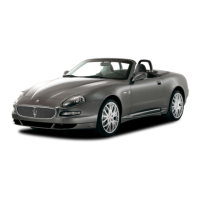7
255
Maintenance and Care
about the available Maserati
Protective Films Kit included in the
“Genuine Accessories” range.
Washing Vehicles with Matte Finish
Paint
• It is recommended to hand wash
vehicles with matte-finish paint.
• Before washing, first remove from
the bodywork dust and other
particles that could damage the
paint. Preferably use an air pressure
jet.
• When grease spots and fingerprints
are present, it is recommended using
a special cleaner for matte finish
paint. Apply the product using a
microfiber cloth. To avoid damaging
the paint surface, do not use too
much pressure.
• Wet the bodywork with plenty of
demineralized water and clean it
using a soft sponge and a neutral
wax-free shampoo, starting from
the top and working down. Dry the
bodywork using an air pressure jet.
• Rinse all the parts of the vehicle
thoroughly with plenty of water.
Keep the sponge or the washing mitt
in use always wet and clean.
• At last, using a different sponge or
washing mitt, clean the wheels, the
door sill plates and the other parts
that are less visible.
CAUTION!
•
It is recommended not to wash the
vehicle in direct sunlight. The little
drops of water, acting as small focal
lenses, could damage the paint.
•
Always and only wash the vehicle by
hand. Avoid using abrasive sponges
or mitts that could damage the matte
finish paint.
•
Never polish and never use polishing
agents on the vehicle with matte
finish paint or on parts of it.
•
Hard water (over 86 °F) could leave
limestone residues.
Glass Surfaces
All glass surfaces should be cleaned on
a regular basis with any commercial
household-type glass cleaner.
Never use an abrasive type cleaner.
Use caution when cleaning the inside
rear window. Do not use scrapers or
other sharp instrument that may
scratch the elements.
When cleaning the rear view mirror,
spray cleaner on the towel or rag that
you are using. Do not spray cleaner
directly on the mirror.
Labels can be peeled off after soaking
with warm water.
Keep all objects a safe distance from
the window.
Cleaning Headlights
Your vehicle has plastic headlights
that are lighter and less susceptible to
stone breakage than glass headlights.
Plastic is not as scratch resistant as
glass and therefore different lens
cleaning procedures must be followed.
To minimize the possibility of
scratching the lenses and reducing
light output, avoid wiping with a dry
cloth. To remove road dirt, wash with
a mild soap solution followed by
rinsing.
Do not use abrasive cleaning
components, solvents, steel wool or
other aggressive material to clean the
lenses.
Condensation and Fogging on the
Light Clusters
With cold or humid climate, after a
driving rain or after cleaning the car,
the surface of the front and rear
light clusters could fog and/or form
condensate drops on the inside. This
is a natural phenomenon due to the
temperature and humidity difference
between the lens internal and external
surface, which nevertheless does

